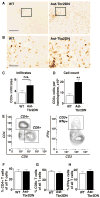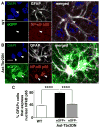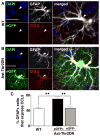Astrocytic TGF-β signaling limits inflammation and reduces neuronal damage during central nervous system Toxoplasma infection
- PMID: 24860191
- PMCID: PMC4075480
- DOI: 10.4049/jimmunol.1303284
Astrocytic TGF-β signaling limits inflammation and reduces neuronal damage during central nervous system Toxoplasma infection
Abstract
The balance between controlling infection and limiting inflammation is particularly precarious in the brain because of its unique vulnerability to the toxic effects of inflammation. Astrocytes have been implicated as key regulators of neuroinflammation in CNS infections, including infection with Toxoplasma gondii, a protozoan parasite that naturally establishes a chronic CNS infection in mice and humans. In CNS toxoplasmosis, astrocytes are critical to controlling parasite growth. They secrete proinflammatory cytokines and physically encircle parasites. However, the molecular mechanisms used by astrocytes to limit neuroinflammation during toxoplasmic encephalitis have not yet been identified. TGF-β signaling in astrocytes is of particular interest because TGF-β is universally upregulated during CNS infection and serves master regulatory and primarily anti-inflammatory functions. We report in this study that TGF-β signaling is activated in astrocytes during toxoplasmic encephalitis and that inhibition of astrocytic TGF-β signaling increases immune cell infiltration, uncouples proinflammatory cytokine and chemokine production from CNS parasite burden, and increases neuronal injury. Remarkably, we show that the effects of inhibiting astrocytic TGF-β signaling are independent of parasite burden and the ability of GFAP(+) astrocytes to physically encircle parasites.
Copyright © 2014 by The American Association of Immunologists, Inc.
Conflict of interest statement
Conflict of Interest: the authors declare no competing financial interests.
Figures










Similar articles
-
Astrocyte gp130 expression is critical for the control of Toxoplasma encephalitis.J Immunol. 2008 Aug 15;181(4):2683-93. doi: 10.4049/jimmunol.181.4.2683. J Immunol. 2008. PMID: 18684959
-
The role of astrocytes in the immunopathogenesis of toxoplasmic encephalitis.Int J Parasitol. 2004 Apr;34(5):543-8. doi: 10.1016/j.ijpara.2003.12.010. Int J Parasitol. 2004. PMID: 15064118 Review.
-
Persistence of Toxoplasma gondii in the central nervous system: a fine-tuned balance between the parasite, the brain and the immune system.Parasite Immunol. 2015 Mar;37(3):150-8. doi: 10.1111/pim.12173. Parasite Immunol. 2015. PMID: 25573476 Review.
-
Astrocytes, microglia/macrophages, and neurons expressing Toll-like receptor 11 contribute to innate immunity against encephalitic Toxoplasma gondii infection.Neuroscience. 2014 Jun 6;269:184-91. doi: 10.1016/j.neuroscience.2014.03.049. Epub 2014 Apr 3. Neuroscience. 2014. PMID: 24704432
-
Characteristics of Infection Immunity Regulated by Toxoplasma gondii to Maintain Chronic Infection in the Brain.Front Immunol. 2018 Feb 5;9:158. doi: 10.3389/fimmu.2018.00158. eCollection 2018. Front Immunol. 2018. PMID: 29459868 Free PMC article.
Cited by
-
The Gelatinase Inhibitor ACT-03 Reduces Gliosis in the Rapid Kindling Rat Model of Epilepsy, and Attenuates Inflammation and Loss of Barrier Integrity In Vitro.Biomedicines. 2022 Aug 29;10(9):2117. doi: 10.3390/biomedicines10092117. Biomedicines. 2022. PMID: 36140216 Free PMC article.
-
Exploration of the involvement of LncRNA in HIV-associated encephalitis using bioinformatics.PeerJ. 2018 Oct 12;6:e5721. doi: 10.7717/peerj.5721. eCollection 2018. PeerJ. 2018. PMID: 30345171 Free PMC article.
-
Parasite infections, neuroinflammation, and potential contributions of gut microbiota.Front Immunol. 2022 Dec 8;13:1024998. doi: 10.3389/fimmu.2022.1024998. eCollection 2022. Front Immunol. 2022. PMID: 36569929 Free PMC article. Review.
-
The Specific Role of Reactive Astrocytes in Stroke.Front Cell Neurosci. 2022 Mar 7;16:850866. doi: 10.3389/fncel.2022.850866. eCollection 2022. Front Cell Neurosci. 2022. PMID: 35321205 Free PMC article. Review.
-
Label-free quantitative proteomic analyses of mouse astrocytes provides insight into the host response mechanism at different developmental stages of Toxoplasma gondii.PLoS Negl Trop Dis. 2023 Sep 18;17(9):e0011102. doi: 10.1371/journal.pntd.0011102. eCollection 2023 Sep. PLoS Negl Trop Dis. 2023. PMID: 37721957 Free PMC article.
References
-
- Farina C, Aloisi F, Meinl E. Astrocytes are active players in cerebral innate immunity. Trends Immunol. 2007;28:138–145. - PubMed
-
- Ransohoff RM, Engelhardt B. The anatomical and cellular basis of immune surveillance in the central nervous system. Nat Rev Immunol. 2012;12:623–635. - PubMed
-
- Carpentier PA, Begolka WS, Olson JK, Elhofy A, Karpus WJ, Miller SD. Differential activation of astrocytes by innate and adaptive immune stimuli. Glia. 2005;49:360–374. - PubMed
-
- Wanner IB, Anderson MA, Song B, Levine J, Fernandez A, Gray-Thompson Z, Ao Y, Sofroniew MV. Glial Scar Borders Are Formed by Newly Proliferated, Elongated Astrocytes That Interact to Corral Inflammatory and Fibrotic Cells via STAT3-Dependent Mechanisms after Spinal Cord Injury. J Neurosci. 2013;33:12870–12886. - PMC - PubMed
-
- Bush TG, Puvanachandra N, Horner CH, Polito A, Ostenfeld T, Svendsen CN, Mucke L, Johnson MH, Sofroniew MV. Leukocyte infiltration, neuronal degeneration, and neurite outgrowth after ablation of scar-forming, reactive astrocytes in adult transgenic mice. Neuron. 1999;23:297–308. - PubMed
Publication types
MeSH terms
Substances
Grants and funding
LinkOut - more resources
Full Text Sources
Other Literature Sources
Molecular Biology Databases
Miscellaneous

